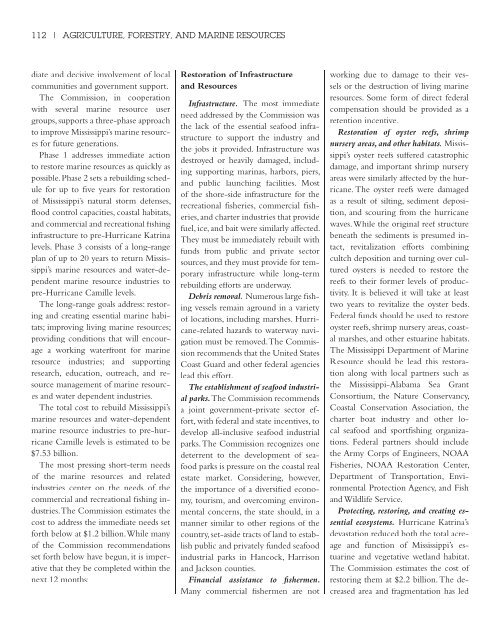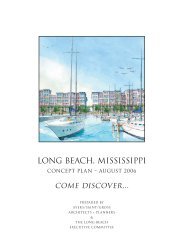Reports - Mississippi Renewal
Reports - Mississippi Renewal
Reports - Mississippi Renewal
- No tags were found...
You also want an ePaper? Increase the reach of your titles
YUMPU automatically turns print PDFs into web optimized ePapers that Google loves.
112 | AGRICULTURE, FORESTRY, AND MARINE RESOURCESdiate and decisive involvement of localcommunities and government support.The Commission, in cooperationwith several marine resource usergroups, supports a three-phase approachto improve <strong>Mississippi</strong>’s marine resourcesfor future generations.Phase 1 addresses immediate actionto restore marine resources as quickly aspossible. Phase 2 sets a rebuilding schedulefor up to five years for restorationof <strong>Mississippi</strong>’s natural storm defenses,flood control capacities, coastal habitats,and commercial and recreational fishinginfrastructure to pre-Hurricane Katrinalevels. Phase 3 consists of a long-rangeplan of up to 20 years to return <strong>Mississippi</strong>’smarine resources and water-dependentmarine resource industries topre-Hurricane Camille levels.The long-range goals address: restoringand creating essential marine habitats;improving living marine resources;providing conditions that will encouragea working waterfront for marineresource industries; and supportingresearch, education, outreach, and resourcemanagement of marine resourcesand water dependent industries.The total cost to rebuild <strong>Mississippi</strong>’smarine resources and water-dependentmarine resource industries to pre-hurricaneCamille levels is estimated to be$7.53 billion.The most pressing short-term needsof the marine resources and relatedindustries center on the needs of thecommercial and recreational fishing industries.The Commission estimates thecost to address the immediate needs setforth below at $1.2 billion. While manyof the Commission recommendationsset forth below have begun, it is imperativethat they be completed within thenext 12 months:Restoration of Infrastructureand ResourcesInfrastructure. The most immediateneed addressed by the Commission wasthe lack of the essential seafood infrastructureto support the industry andthe jobs it provided. Infrastructure wasdestroyed or heavily damaged, includingsupporting marinas, harbors, piers,and public launching facilities. Mostof the shore-side infrastructure for therecreational fisheries, commercial fisheries,and charter industries that providefuel, ice, and bait were similarly affected.They must be immediately rebuilt withfunds from public and private sectorsources, and they must provide for temporaryinfrastructure while long-termrebuilding efforts are underway.Debris removal. Numerous large fishingvessels remain aground in a varietyof locations, including marshes. Hurricane-relatedhazards to waterway navigationmust be removed. The Commissionrecommends that the United StatesCoast Guard and other federal agencieslead this effort.The establishment of seafood industrialparks. The Commission recommendsa joint government-private sector effort,with federal and state incentives, todevelop all-inclusive seafood industrialparks. The Commission recognizes onedeterrent to the development of seafoodparks is pressure on the coastal realestate market. Considering, however,the importance of a diversified economy,tourism, and overcoming environmentalconcerns, the state should, in amanner similar to other regions of thecountry, set-aside tracts of land to establishpublic and privately funded seafoodindustrial parks in Hancock, Harrisonand Jackson counties.Financial assistance to fishermen.Many commercial fishermen are notworking due to damage to their vesselsor the destruction of living marineresources. Some form of direct federalcompensation should be provided as aretention incentive.Restoration of oyster reefs, shrimpnursery areas, and other habitats. <strong>Mississippi</strong>’soyster reefs suffered catastrophicdamage, and important shrimp nurseryareas were similarly affected by the hurricane.The oyster reefs were damagedas a result of silting, sediment deposition,and scouring from the hurricanewaves. While the original reef structurebeneath the sediments is presumed intact,revitalization efforts combiningcultch deposition and turning over culturedoysters is needed to restore thereefs to their former levels of productivity.It is believed it will take at leasttwo years to revitalize the oyster beds.Federal funds should be used to restoreoyster reefs, shrimp nursery areas, coastalmarshes, and other estuarine habitats.The <strong>Mississippi</strong> Department of MarineResource should be lead this restorationalong with local partners such asthe <strong>Mississippi</strong>-Alabama Sea GrantConsortium, the Nature Conservancy,Coastal Conservation Association, thecharter boat industry and other localseafood and sportfishing organizations.Federal partners should includethe Army Corps of Engineers, NOAAFisheries, NOAA Restoration Center,Department of Transportation, EnvironmentalProtection Agency, and Fishand Wildlife Service.Protecting, restoring, and creating essentialecosystems. Hurricane Katrina’sdevastation reduced both the total acreageand function of <strong>Mississippi</strong>’s estuarineand vegetative wetland habitat.The Commission estimates the cost ofrestoring them at $2.2 billion. The decreasedarea and fragmentation has led




